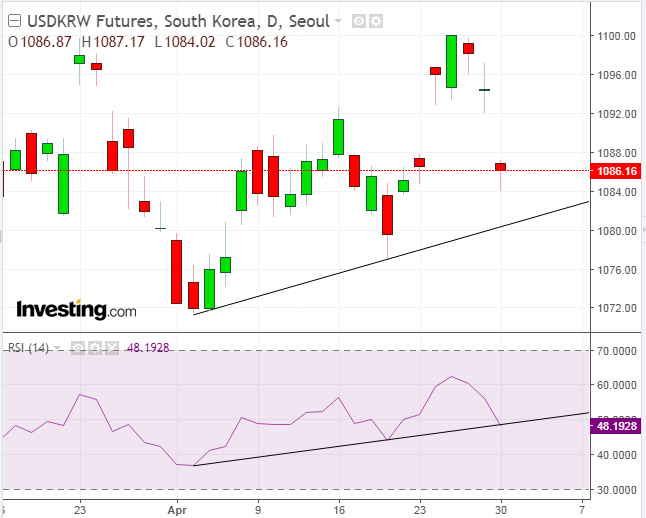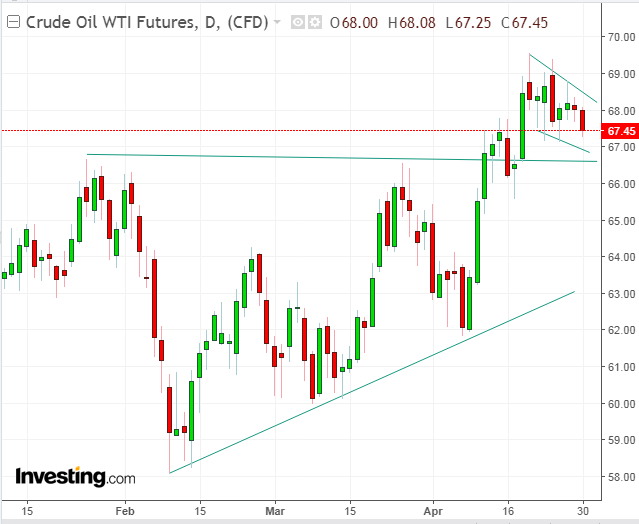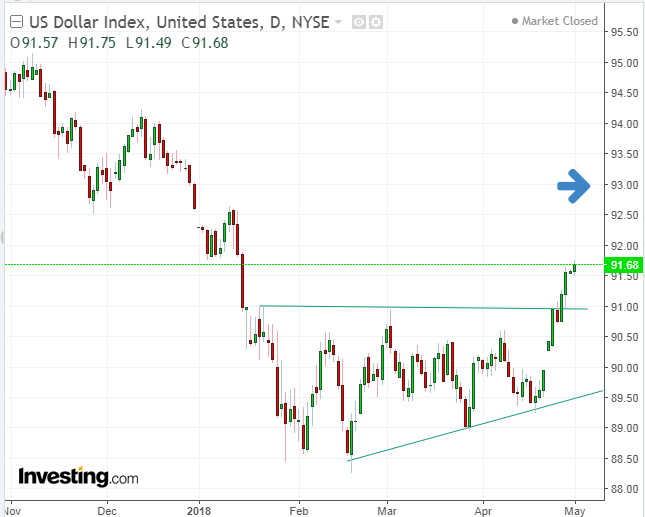- European miners, beverage companies underperform; media, telecom outperform
- Won advances on North/South Korean reconciliation
- GBP falling on home secretary resignation, potentially completing double top
- Global data continues to suggest a peak, though some say it's temporary
- Oil weighed down by dollar but on the verge of another upside breakout
- Earnings releases continue this week: Apple, McDonald's, Tesla and others.
- The Federal Open Market Committee begins a two-day meeting on Tuesday. Economists forecast Fed policy makers will probably keep their target rate for overnight bank lending in a range of 1.5 percent to 1.75 percent.
- It’s Golden Week in Japan, with public holidays Monday, Thursday and Friday. China markets are shut on Monday and Tuesday.
- The Reserve Bank of Australia’s monetary policy decision is out Tuesday. The central bank is expected to keep rates on hold, as they’ve been for more than 1 1/2 years.
- The European Commission releases its spring economic forecasts, which include projections for growth, inflation, debt and deficit, and unveils its proposal for the EU’s seven-year budget framework on Wednesday.
- Nonfarm payroll gains in the US likely picked up in April, with the unemployment rate forecast to drop to 4 percent, according to surveys of economists. Numbers will b released on Friday.
- McDonald's (NYSE:MCD) reports Q1 2018 earnings today before market open, with a $1.67 EPS forecast vs $1.47 for the same quarter last year.
- Pfizer (NYSE:PFE) is expected to report earnings tomorrow before market open, with a $0.74 EPS estimate, versus $0.69 of the same quarter last year.
- Apple (NASDAQ:AAPL) is scheduled to report results tomorrow after the market close, for the fiscal quarter ending March 1, wtih a $2.69 EPS forecast, vs $2.1 for the same quarter last year.
- Snap (NYSE:SNAP) also reports tomorrow. Investors will be watching to see if they can emulate Facebook (NASDAQ:FB) when it was at a similar stage in its evolution and crush expectations quarter-after-quarter. The social media company is expected to report revenues of $243.3M on EPS of $0.29.
- Tesla (NASDAQ:TSLA) reports earnings Wednesday after the market close, with a $ -4.45 EPS forecast, compared to $ -1.97 for the same quarter last year.
- The Stoxx Europe 600 Index declined 0.1 percent.
- The MSCI All-Country World Equity Index gained 0.2 percent to its highest in more than a week.
- Futures on the S&P 500 Index increased 0.3 percent to the highest in more than a week.
- The U.K.’s FTSE 100 advanced 0.2 percent to the highest in almost three months.
- The Dollar Index climbed 0.04 percent to the highest since January 15.
- The South Korean Won increased 0.8 percent to 1,068.05 per dollar, the strongest in more than a week.
- The euro was unchanged at $1.213.
- The British pound fell 0.1 percent to $1.377, is weakest in two months.
- The yield on US 10-year Treasuries climbed one basis point to 2.97 percent.
- Germany’s 10-year yield gained one basis point to 0.59 percent, the largest gain in a week.
- Britain’s 10-year yield gained one basis point to 1.445 percent, the biggest gain in a week.
- Gold decreased 0.5 percent to $1,317.27 an ounce.
- West Texas Intermediate crude dipped 0.9 percent to $67.47 a barrel, the lowest in almost two weeks.
- LME aluminum declined 0.2 percent to $2,218.00 per metric ton, the lowest in almost three weeks.
- LME copper advanced 0.2 percent to $6,812.50 per metric ton.
Key Events
Stocks stumbled in Europe this morning, opening lower. Miners and beverage companies dragged the STOXX Europe 600 down, while media and telecom shares helped with a rebound, leading to a minor gain. That occurred on the heels of a strong Asia session earlier, when all major regional benchmarks—except for markets in China and Japan which were closed for holidays—gained. US futures for the S&P 500 as well as the NASDAQ 100 are both trading higher, suggesting their underlying benchmarks could continue the global advance that started today in Asia.
Global Financial Affairs
Though markets in China were closed for Labor Day and Japanese markets were shuttered for Shōwa Day observance, Hong Kong's Hang Seng outperformed, thanks to financials and property stocks. Although the Shanghai exchange was closed, investors were able to bid up shares of mainland banks traded in the city, after its five largest banks, including the China Construction Bank (HK:0939) and the Agricultural Bank Of China (HK:1288) posted their fastest first quarter profit growth in 4 years.
The South Korean won reached a one week high, as prospects for peace between South and North Korea seem more possible after the leaders of both countries met late last week.
North Korea pledged denuclearization ahead of an unprecedented meeting between North Korea's Kim Jong Un and US President Donald Trump. It will be interesting to see what impact—if any—this may have on Mideast geopolitics, as Trump takes on the Iranian nuclear accord, which he's expected to overturn.
As for the reconciliation between North and South Korea, actual steps taken so far have been largely symbolic and include South Korea's removal of propaganda broadcasting loudspeakers along the border with North Korea and alignment of the two country's time zones. Technically, the price of the dollar versus the won retreated from the day's low to form a potential bullish hammer, after nearing an uptrend line since the beginning of the month. The RSI too is testing its uptrend line for the same period.
Stocks in Seoul were not weighed down by the strengthening currency. The easing of regional geopolitcial risk as well as the expectation that some of the economic benefits to Pyongyang would trickle down to Seoul lifted the KOSPI higher.
Investor reaction was slow, but nonetheless decisive this morning after Prime Minister Theresa May's ally UK Home Secretary Amber Rudd resigned. Initially, the pound shrugged off the news but was then sold off.
Technically, it took traders 16 months to bid up the pound from its near 20 percent selloff after the June 24, 2016 Brexit vote, which took 3 months and change. The current fall is nearing the neckline of a double top since January 25. Although at the April 17 peak, the left top's $1.4378 exceeded the $1.4345 former top posted on January 25, the RSI suggests declining momentum when falling lower, providing a negative divergence.
End of the Global Growth Story?
Data on Friday showed the US economy cooled in the first quarter: GDP came in at 2.3 percent, though not as low as the 2.0 percent forecast, amid the weakest consumer spending release in almost 5 years. It is estimated, however, that this setback is only temporary since it's set against the backdrop of a tightening labor market and large fiscal stimulus.
The UK posted GDP of just 0.1 percent, its slowest read since 2010, from 0.4 percent in the previous quarter, weighed down by a sharp fall in construction output and a weak manufacturing sector.
France's growth also slipped, despite President Emmanual Macron's business push. National statistics agency INSEE estimated growth between January and March at 0.3 percent GDP compared with the same period last year, a steep drop from expansion of 0.7 percent in the last quarter of 2018.
As well, China's manufacturing sector, perhaps a leading indicator of global demand, showed signs of slowing. The government's manufacturing PMI, posted today, dropped to 51.4 in April from 51.5 in March. On the plus side, it's above the 50-point level that separates expansion from contraction; it is the 21st straight monthly expansion. Then again, such a long stretch of growth would take place before a peak.
In the US in particular, investors are torn between killer earnings and concerns of higher interest rates, which could lead to an economic peak, followed by a market decline. Last week, results from tech giants including Microsoft (NASDAQ:MSFT), Intel (NASDAQ:INTC) and Amazon (NASDAQ:AMZN) boosted US equities before the weekend. Still, US stocks were flat for the week.
Technically, the price of oil is trading within a bullish falling flag, as part of a return move to retest a bullish ascending triangle.
The dollar edged higher.
The Ascending Triangle implies a target of 93.00, suggesting the Dollar Index still has room to go higher.
Up Ahead
Market Moves
Stocks
Currencies
Bonds
Commodities
Which stock should you buy in your very next trade?
AI computing powers are changing the stock market. Investing.com's ProPicks AI includes 6 winning stock portfolios chosen by our advanced AI. In 2024 alone, ProPicks AI identified 2 stocks that surged over 150%, 4 additional stocks that leaped over 30%, and 3 more that climbed over 25%. Which stock will be the next to soar?
Unlock ProPicks AI




